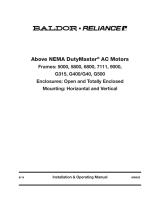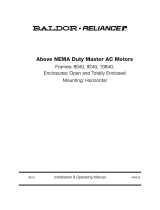
795-21486
INSTRUCTIONS for OPERATION
and
MAINTENANCE
Graymills
LV
SERIES
PUMPS
DESCRIPTION
AND
OPERATING
CHARACTERISTICS
a) LV
sen
e s
pumps
are
of
centrifugal
type
designed
for li
quids
of
light
viscosity.
Standard
pumps
are
made
to
operate
at
viscosities
no
higher
than
400
SSU.
Special
models
may
operate
at a
higher
viscosity.
b)
LIquid
is
drawn
in
through
the
bottom
intake
and
discharged
at
relatively
low
pressure.
Because
of
the
low
pressure,
restrictions
such
as
small
J.D.
tubing
and
heavy
viscosity
will
reduce
flow
drastically.
c) Do
not
run
dry,
the
bushing
may
be
damaged.
II
MAXIMUM
VISCOSITY
RANGE
FOR
"SAFE"
OPERATION
a)
Standard
LV
Series
pumps
can
operate
with
liquids
having
a
maximum
viscosity
of
400
SSU
without
overloading
the
motor.
For
heavier
viscosities
a
motor
of
the
next
larger
horsepower
IS
generally
used.
Check
this
spec
ific a
tiou
as
it mav or may
not
have
beeu
cou
si
der
ed in
ordering.
tl) Rot.arv an
morors
cunnot
I.>~
o
ver
l
oad
ed or
inJllTPo
hy
hpavy
V1SCilSily
Of b md
ing.
They
will mer elv
stop
turning.
c)
The
p\llllP
will
deliver
less
flow as
the
viscosity
increases.
Temperature
may
affect
vi s co
srtv.
The
vi
scos
ity
of a 100 SSU
oil,
for
example,
may
iucrease
suhstantially
as
it
gets
colder.
It'
the
liquids
are
too
heavy,
the
motor
will
slow
down
and
stall.
Overload
protection
is
reco
nunended.
III
ABRASIVE
RESISTANCE
OF
MATERIALS
a) LV
pumps
in
shorter
lengths
have
a
labyrinth
and
there
is
no
metal
to
metal
or
bearing
contact.
Such
models
can
be
used
with
abrasive
slurries
and
pigments.
Longer
models
have
a
carbon
thrortle-bustnng
above
the
impeller
to
give
support
to
the
shaft.
The
bushing
and
shaft
sleeve
may
wear
consrderublv
without
materially
affecting
the
pump
performance
even
though
some
liquid
will
leak
through
the
bushing
area.
IV
CHEMICAL
RESISTANCE
OF
PLASTICS
USEDIN
CONSTRUCTION
a)
The
pump
bodies,
impeller
and
impeller
nut
are
made
in GM2GY,
and
GM2GG
which
are
a
thermoplastic
combining
high
mecharu
cal
strength,
stiffness
and
stability
through
a
broad
range
of
temperatures.
It
has
excellent
chemical
resistance,
but
not
eomplete
ehemieal
resistance.
It
can
be
used
for
water,
many
solvents
such
as
heuziue
and
toluene,
chlorinated
hydrocarbons,
ketones,
water
and
detergent
solutions,
hrine
and
many
inorganic
chemicals
used
in
cleaning
Or
processing.
b)
The
pump
column
is
made
of No.
316
or No.
302
stainless
steel.
Chemieal
resistance
should
be
determined
hy
the
customer
in
consultu
uon
with
Graymills.
c)
Con
sult
the
factory
on
specific
applications
of t.he LV pump
with
chemic
al s
which
may
have
an
effect
on
materials
of
construction.
Our
ehemical
resistance
intormanou
is
hased
upon
datu
supplied
hy
the
basic
plastic
manufacturers
and
/ or
Gruynu
ll s
tests.
The
user
should
conduct,
his
own
test
where
there
is
any
que
st
ion
about
the
s ni tnb ili ty of pl a
st
ic s or
metals,
strength,
etc.

X
DISASSEMBLY,
or TO
REPLACE
BUSHING
OR
V EFFECT OF TEMPERATIJRE ON
CHEMICAL
RESISTANCE SHAFTSLEEVE
a) Pumps should
not
be used conftnuously with temperatures exceeding ISSoF without consultation
with the factory. (Actual maximum temperature for GM2GY is substantially higher; a) Remove the
screws
holding
the
volute
cover
plate
to the
however, pumping some liquids at elevated temperatures for long periods may cause gradual deteriora- body and remove
cover
plate
with
gasket.
tion of the plastic, brittleness or crazing or loss of strength in wall thickness.) GM2GY may be used with
water up to 170
0F.
b) Remove the
cotter
pin and
then
the
impeller
retaining
b) Example: A
pump
made
ofGM2GY
plastic was operated for 1400 hours in oil at a temperature of
nut.
194
0F.
No malfunction or leaks were evident but the plastic parts had decreased in thickness The c) Withdraw the
impeller.
same type
of
pump operated in
IS0
0F.
oil showed absolutely no loss. Obviously, if a user were to op-
erate occasionally at the higher temperature and then remove the pump or permit the oil to cool, d)
The
shaft
sleeve
is
now
accessible
and may be
inspected
CJ
many years of service could be expected before the breakdown point was reached. or removed by
releasing
the
spring
which
holds
it to the
shaft.
CI
c
COUPLING
e) The
bushmg
can
now be
inspected.
To remove the
bushing:
VI EFFECT OF TEMPERATURE ON
VISCOSITY
c
a) The viscosity
of
some liquids like oil will change with the temperature. This will affect the flow. f)
Take
out the
screws
holding
the
upper
volute
to the pump
MOTOR
The thicker the liquid, the less the flow. The effect is much more noticeable when small piping or tub-
column,
then
pull the
volute
from the
column.
ing is used. If delivery is critical, make
s~lfe
that the tests are conducted with liquids 'at the tempera- g)
Push
the
bushing
from the vol ute.
I I
COLUMN
tures at which they will normally be operating or within the range in which they may operate.
FLANGE
h) The pump
column
can
be removed from motor as one
unit
l-I
I
VII ELECTRICALCONNECTIONS by removing motor
bolts
and
dropping
the column.
(This
will
a) Check your electric current with the voltage, cycle and phase
of
the motor. LV pumps should ro- not be
necessary
for
bushing
or
sleeve
replacement.)
tate in a clockwise direction when looking at the intake end
of
a pump (with
motor
away from you).
3-Phase motors can be wired to run in either direction. Make sure the
motor
is running in the right i)
If
it is
necessary
to remove the
shaft
from the motor,
take
direction. When running backwards the pump will deliver at reduced flow but no harm will be done.
out
the
set
screws
and
carefully
support
the coupl
ing
then
Grounding the
motor
is recommended. Overload protection is recommended.
drive
out the
pin.
DO NOT DISTURB THE ALIGNMENT OF
VIII
MOUNTING
THE
SHAFT.
a) Use care in making connections. LV Series pumps are of strong construction. The wall thickness of
the plastic is such
that
there is excellent shock and impact resistance, however, care should be used in
handling. The discharge is
3/4"
standard pipe thread..
COLUMN
XI
REASSEMBLY
b) Tapered pipe threads should be carefully tightened to avoid fracturing plastic. Pipe sealing com- a)
Reverse
the
procedure
in X. Make
sure
the
shaft
is
pounds are not generally required because
of
the excellent sealing
of
the metal pipe thread to the running
true.
plastic. SHAFT
c) Pump should be
mounted
vertically with the impeller covered by liquid. Do not block the intake XII
LABYRINTH
by resting the
pump
too close to the
bottom.
a)
Labyrinth
used
in
place
of
bushing
and
sleeve
on
certain
d) To get the greatest possible flow, use the maximum size pipe, hose or tubing. Use Gate valves and
models.
not Globe valves. Avoid fittings which tend to offer restrictions, even though they may appear to be
of
adequate size externally. b) The \4"
thick
slinger
is
pressed
on
shaft
with two
teflon
washers
sandwiched
between
slinger
and upper
half
of
IX
WHAT
TO CHECKIF FLOWIS REDUCED
BELOW
RATEDOUTPUT
labyrinth.
SLEEVE
&
a) Is
pump
running in the right direction? (3 phase only)
SL
INGER
BUSH
I NG
SHAFT
--
H I I
......
" " i
RETAINER SPRING
b) Are there any unusual restrictions in the piping such as crimped hose, excess fittings, small tubing,
etc.?
c) Is the
motor
running on the
correct
voltage, cycle, and phase?
UPPER
d) Is the liquid
too
heavy or did temperature decrease make it so? Some liquids will also get thicker
i.
VOLUTE
when pumper.. Some will be thicker when quiet and will thin out when pumped.
b.
2
Teflon
e) Is the pump intake starved or is the
pump
above liquid level and not priming? IMPELLER
f) If a long
pump
is used in a deep
tank
the lift is determined by the distance from the top
of
the liq- Tl"""
uid to
point
of delivery. As liquid is pumped down the lift will be greater and less flow will result.
NUIT
g) Check for binding within the
body
of the pumps caused by rags, strings or chips. LABYRINTH
h) Make sure pump intake is not in the sludge, slurry, or is not directly on the
bottom
of the container
which will restrict the intake. .-
cJ=p'
~~~~~
c::::::::IC~~~
~Jbl!.~~~~~
SHAFT

WARRANTY
Graymllls Corporation warrants that the equipment manufactured and delivered,
when properly Installed and maintained, shall be free from defects in workmanship
and will function as quoted in the published specficauon. Graymills does not
warrant process performance, nor assume any liability for equipment selection,
aoapnon. or Installation.
Warranty
does
not apply to
damages
or defects caused by shipping, operator
carelessness, misuse, improper application or equipment which
damages
or impairs
the proper function of the unit, and modifications made to the Unit. Warranty
does
not
apply
to expendable parts needing replacement pencocauv due to normal wear
and tear.
A new Warranty
penod
shall not be established for repaired or replaced rnatenals or
prcducts
Such Items shall remain under Warranty for only the remainder of the
Warranty period of the original material or product.
THE FOREGOING WARRANTIES ARE IN LIEU OF ALL OTHER WARRANTIES,
WHETHER ORAL, WRITIEN, EXPRESSED, IMPLIED OR STATUTORY GRAYMILLS
CORPORATION MAKES NO OTHER WARRANTY OF ANY KIND, EXPRESS OR
IMPLIED, ALL IMPLIED WARRANTIES OR MERCHANTABILITY AND FITNESS FOR A
PARTICULAR PURPOSE WHICH EXCEED THE AFORESTATED OBLIGATION ARE
HEREBY DISCLAIMED BY GRAYMILLS CORPORATION AND EXCLUDED FROM
THIS SALE Graymilis warranty obligations and Buyer remedies (except to title), are
solely and exclus.vely stated herein In no case will Graymills be liable for
conscquentral damages, loss of production, or any other loss incurred due to
Interruption of service.
Graymills' obligation under this Warranty shall be limned
to:
(a) Repairing or replacmq (at Graymllls sole discretion) any non-conforming
or defective
component
within one year from the date of shipment from
Graymills
(b) Repalnng or replacing (at Graymills sole discretion),
components
supplied by, but not manufactured by Graymills, to the extent of the
warranty given by the onqmal manufacturer.
Buyer must give Graymllls prompt notice of any defect or failure.
If you believe you have a Warranty claim, contact Graymills at (773) 248-6825. Any
return material must have an RMA number on the outside of the
package
and
Shipping prepaid or shipment Will be refused Graymills will promptly examine the
material and determine If it is defective and Within the Warranty period.
Graymills
3705
N. Lincoln Ave., Chicago, Illinois
60613
USA 7731248·6825 FAX
7731477·8673
/

